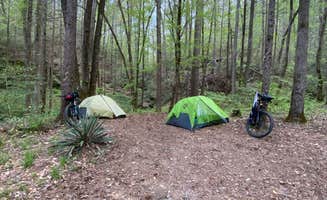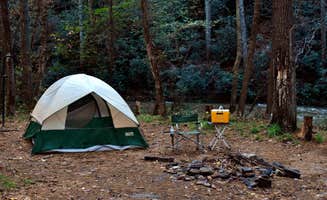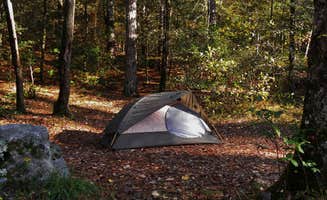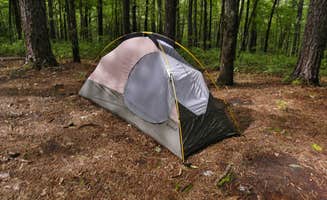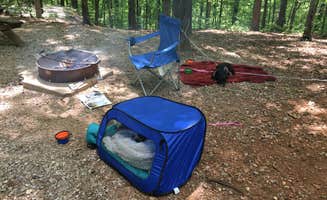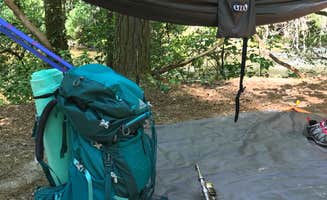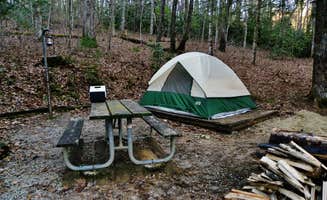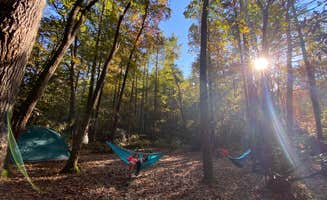Primitive camping opportunities abound within the Sumter National Forest near Seneca, South Carolina. The area features elevations ranging from 800-1,800 feet with mixed hardwood forests and multiple river systems. Fall temperatures typically drop to 40-50°F at night, while summer camping can be hot and humid with daytime temperatures regularly exceeding 85°F.
What to do
Trout fishing access: At Burrells Ford, the Chatooga River offers excellent angling. "Good amount of camping with a short hike in. Sites are right on the Chatooga River. This river is stocked with trout. Fishing license is required but both SC and GA are acceptable as the river is the state line," notes Jason D.
Waterfall exploration: A 0.5-mile hike from Burrells Ford leads to King Creek Falls. Many campers combine this with riverside camping: "Short hike to King Creek Falls," mentions one visitor, making it an easy day trip from camp.
Swimming holes: Summer months provide cooling options in the river. Elise W. shares that Burrells Ford is "Great for swimming and Hammocking!" The deep pools near many campsites offer natural swimming areas without developed facilities.
Hiking connections: The Foothills Trail runs through several camping areas. From Jocassee Gorges Wildlife Management Area, "There are so many campsite available through Jocassee. Currently my favorite campsites lie off of the Canebrake Trail and connect with the Foothills Trail," explains Maggie J.
What campers like
Private riverside sites: Campers consistently mention site separation as a benefit. At Grapevine, "Sites are spread out, nice river nearby," reports one camper. This provides more privacy than typical developed campgrounds.
Natural soundscape: The rushing water creates a natural white noise. As one camper at Riley Moore Falls Campsite describes: "I took my hammock and spent the night listening to the waterfall and nature. Sky was clear and bright with stars."
Wildlife viewing: Bear-safe food storage systems are provided at some sites. The natural forest setting supports diverse wildlife. "We've encountered deer, skunks, opossums, raccoons, bobcats, bears and a wide variety of snakes," reports one experienced camper.
Off-grid experience: Cell service is absent in most areas, creating a true disconnect. "No cell service and small wildlife encounters. More for experienced campers. It's a wonderful place to go and disconnect from everything," notes Austin G. about Big Bend.
What you should know
Access challenges: Many of the best tent camping near Seneca requires high-clearance vehicles. For Blue Valley Dispersed Camping, "The pavement will end in a half mile. Just stay on the main path for just little over 3 or so miles." Lower vehicles may struggle on these routes.
Limited facilities: Bring everything needed including water. "All water has to be taken in since there are no sources of water within miles. This is true primitive camping," explains one camper about Sumter National Forest camping.
Weather preparation: Temperature swings can be significant. One family camping at Burrells Ford reported: "It dropped to 17 degrees and our plan to stay in 2 tents quickly changed to everybody in the 4-man/3-season tent that we had just purchased."
Weekend crowds: Popular sites fill quickly, especially in summer. "I've heard it gets overrun with spring breakers," warns Tony E. about Burrells Ford. Mid-week camping offers better solitude.
Tips for camping with families
Terrain considerations: Some campsites require steep descents. For Sumter National Forest's primitive sites, "To get to this campground, you have to drive two and a half miles down a forest road, and then you hike about a third of a mile to the campsites."
Gear transport solutions: Consider equipment for moving supplies. "Saw a Father and son taking there stuff down with a hand truck which is a very good idea. So you can either backpack it in or take a wagon to take your stuff in," recommends Donnie S. about Burrells Ford.
Educational opportunities: Panther Creek Recreation Area provides nature learning chances. "The hike is a little challenging to first timers and you do have to be careful on some of the cliff sides but it looks beautiful," explains Daniel L. The area includes diverse plant communities for impromptu nature lessons.
Seasonal planning: Early fall provides ideal family camping weather with fewer insects. "In early fall, when all the flowers are in bloom. (See pictures attached- I love taking pictures of flowers! I cant help it)," shares one camper about spring and summer visits.
Tips from RVers
Site access limitations: Most dispersed camping near Seneca cannot accommodate large RVs. "You cannot drive to this site with a low clearance sedan. It is almost impossible without scraping the bottom of your car. Fortunately, I had a 4-Runner, and I was using 4WD," explains Myron C. about Big Bend Campground.
Alternative options: For RVers seeking primitive experiences, Denver Downs Farm offers large open spaces. "This is a farm and outdoor event center with a 140 acre field you can camp in...There are no defined campsites we could see. Just a giant field to set up and camp," reports Adam V.
Road conditions: Forest service roads can be problematic for trailers. "Pretty rough in some places and very narrow, let's just say I wouldn't want to end up encountering another car," warns one camper about Blue Valley's access roads.


